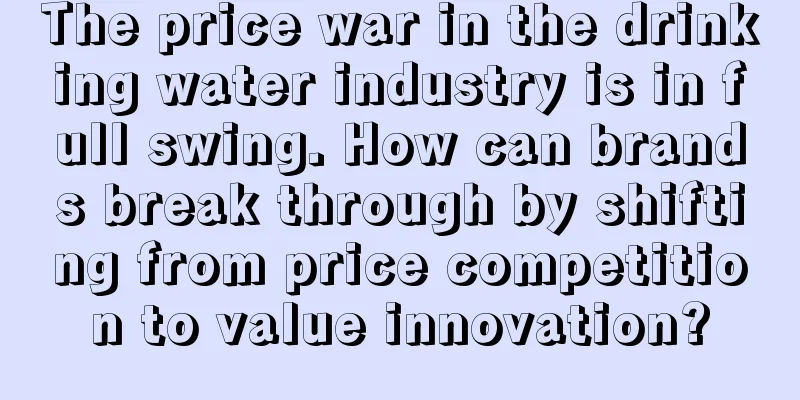The price war in the drinking water industry is in full swing. How can brands break through by shifting from price competition to value innovation?

The hot summer is the peak consumption season for fast-moving consumer goods such as drinking water, but China's drinking water industry is experiencing an unprecedented price war storm. Nongfu Spring, which is regarded as the "water king" in the drinking water industry, experienced a quality inspection incident by the Hong Kong Consumer Council some time ago. Its head Zhong Shanshan lamented in his circle of friends: "Competitors are ruthless and ruthless. If Nongfu Spring was not tough, it would have been killed long ago!" Subsequently, Nongfu Spring took the lead in launching a price war, hoping to grab back the lost market share through price. It is understood that in a chain supermarket in Beijing, the promotional price of Nongfu Spring's 12-bottle green bottled water has dropped to 8.9 yuan, equivalent to only 0.74 yuan per bottle. This price once shocked consumers. The price of Nongfu Spring green bottle in a supermarket in Beijing is as low as 8.9 yuan/12 bottles. Source: Internet However, while people were still marveling at Nongfu Spring's fierce momentum as a price butcher, they did not know that it might not have tasted the sweetness of increased sales brought by low prices, but only ignited a fierce price war storm, and the severity of the subsequent battle was beyond the imagination of most people. For a time, domestic drinking water brands joined the price war one after another. Wahaha, Yilibao, Jingtian, Jinmailang and other companies lowered the prices of their products and moved the battle line from offline to online, all hoping to stabilize their market share by lowering prices. In offline supermarkets, prices such as 9.9 yuan for Master Kong boiled water, 12 yuan for Yilibao purified water, 9.9 yuan for Jingtian drinking purified water, and 6.9 yuan for Jinmailang blue label packaged drinking water have become the norm. If you enter keywords such as mineral water and Nongfu Spring on online food delivery platforms, you will not only see regular drinking water products with the same price as offline, but also a large number of promotional activities such as 0.1 yuan for limited water. Even some high-end mineral water brands have begun to "lower their profile". For example, Nongfu Spring's high-end natural snow mountain mineral water product "Changbai Snow" and Jingtian's aristocratic water "Baishuishan" have also lowered their prices. The entire Chinese drinking water industry has been caught in the smoke of a price war. Many drinking water brands have joined the price war, and high-end brands are no exception. Source: Internet This round of price war suddenly broke out in China's drinking water industry. Its speed and ferocity left many people confused. How did all this happen? The author believes that this is the result of the combined effect of multiple factors, including the homogeneous nature of drinking water products themselves and consumers' high sensitivity to their prices, consumers' high requirements for the "value for money" of goods in the current economic adjustment cycle, and the fierce competition within China's drinking water industry. 01 Analysis of the causes of China's drinking water price warFirst, drinking water products themselves lack differentiation and consumer demand has strong price elasticity. The functional differences of drinking water products themselves are relatively small, which is determined by their basic properties. As a necessity, the core function of water is to quench thirst and meet the body's water needs. From the perspective of chemical composition, the basic differences between different brands of drinking water are often not large. Although drinking water products on the market can be divided into tap water, purified water, mineral water, natural spring water and other types according to their sources and treatment processes, each type may have slight differences in mineral content, pH value, taste, etc., but these differences are not significant to ordinary consumers, and it is difficult to form strong brand loyalty. Consumer demand for drinking water is highly price elastic, which means that price changes have a greater impact on demand. When the price of drinking water drops, consumers tend to buy more water or switch to lower-priced brands; conversely, price increases may lead to a decrease in demand, and consumers may switch to substitutes or reduce consumption. Moreover, this price sensitivity is particularly evident among consumers with average economic conditions, who react more strongly to prices. Secondly, in the context of the current economic adjustment cycle, consumers have higher requirements for the “value for money” of goods, and this is more obvious in daily consumer goods such as drinking water. Changes such as increased uncertainty in the job market and slower growth in household income brought about by the slowdown in economic growth will directly affect consumers' purchasing power and confidence. Consumers will tend to become more cautious and be more calculating in every penny they spend, striving to maximize the value of their funds. However, as the consumption upgrading trend brought about by economic and social development has not changed, consumers' expectations for the value they get from goods have been raised to a very high level. They hope to get higher value from goods for the same amount of money, that is, they require goods to have a higher "value for money". This is consistent with the view I have always held: consumption upgrading is not just about higher product pricing and better appearance design, but about improving the brand's "value for money". In the past, people often talked about price/performance ratio, that is, product performance/price, which reflects the product functions and performance that can be obtained with a unit of currency. This mainly focuses on the partial rational value of the product, but cannot fully reflect all the value that consumers obtain from the consumption process. I believe that consumers will gain at least the following value from the consumption process:
Therefore, we can summarize a formula: value-for-money ratio = comprehensive value provided by the product/product price. If a consumer judges that the value he gets from a brand is higher after paying a unit price, he will tend to choose this brand. The functional value of drinking water is not much different, and it is difficult and time-consuming to improve other values, which makes brands tend to improve the "value-to-price ratio" by lowering prices in order to attract consumers to buy. Therefore, price wars are easily regarded by drinking water brands as an important strategy to compete for market share. In addition, it cannot be ignored that the fierce competition in China's drinking water industry has also magnified the impulse of brands to start price wars. According to public data, the main competitors in China's packaged drinking water market include brands such as Nongfu Spring, C'estbon, Baishuishan, Master Kong and Wahaha, presenting a "one super and many strong" competition pattern. Among them, Nongfu Spring ranks first, with a market share of about 26.5%; China Resources C'estbon ranks second, with a market share of about 21.3%; Master Kong ranks third, with a bottled water market share of about 10.1%; Wahaha ranks fourth, with a market share of about 9.9%; Baishuishan ranks fifth, with a market share of about 7.4%; Ice Dew ranks sixth, with a bottled water market share of about 5.3%. Source: Public information, compiled by Guanyan Tianxia Source of charts: Guanyan Tianxia In addition to these big brands, there are also many small local brands in the market. If you search for keywords such as pure water and drinking water on e-commerce platforms, you will see drinking water brands that are rarely seen offline. They are also trying to participate in the competition, hoping to get a piece of the huge drinking water market. It cannot be ignored that many giant players outside the industry have been trying to enter this field to cut a piece of the pie, such as Evergrande Ice Spring in previous years and Oriental Selection recently, which has further intensified the fierce competition in the industry. In addition, other beverages such as sparkling water, carbonated drinks, ready-to-drink tea/coffee, and freshly brewed tea/coffee are also consumer substitutes for drinking water, which has also increased the pressure faced by the drinking water industry. Fierce competition has forced drinking water brands to work harder to gain a competitive advantage, thereby stimulating their strong urge to launch price wars. 02 Price wars are not conducive to the long-term healthy development of brands and industriesHowever, everyone knows that price war is a double-edged sword, which will have adverse effects on the sustainable and healthy development of individual brands and the entire industry. For brands, the direct consequence of price wars is often a decline in profit margins. When brands compete to cut prices to gain market share, if there is no effective cost control, the profit margin will be severely squeezed. In the long run, it may erode the profitability of the brand and even lead to operational difficulties. In addition, frequent price wars may damage brand positioning and image, and make consumers form the impression that the brand is cheap, which is particularly dangerous for brands that try to establish a high-end or high-quality image. Under the pressure of price wars, companies may reduce investment in R&D and innovation, because reducing costs and maintaining price competitiveness in the short term become the top priorities, which will undoubtedly weaken the brand's future competitiveness. For the entire industry, price wars may also bring a series of negative effects. When all participants are involved in price wars, the overall profit level of the industry will drop significantly, which not only affects the return on investment, but also may inhibit the long-term development and innovation of the industry. In addition, price wars may lead to a deterioration of the market environment, and consumers will begin to pay too much attention to prices and ignore product quality and brand value, which is unfair to those brands that focus on providing high-quality products and services. Long-term price wars may also reduce consumers' trust in the entire industry. If consumers believe that large price fluctuations mean unstable product quality, the reputation of the entire industry and consumer confidence will be damaged. Therefore, the author would like to remind drinking water brands that they can engage in short-term price wars, but they should know when to stop and adhere to the long-termism of brand development: focus on differentiated competition driven by value innovation, comprehensively enhance the value that products provide to consumers, thereby improving the "value-to-price ratio" to gain consumer recognition and establish their own competitive advantage. If this can be achieved, the brand can even "raise prices" in a healthy way to obtain higher profits. 03 How to drive the improvement of “value-to-price ratio” through value innovationFirst of all, the brand must clarify its target audience and its own positioning, and on this basis carry out product innovation to enhance functional value. For example, if your target market is young consumers with a strong health consciousness, you can develop new products accordingly: drinking water rich in minerals and trace elements, or adding functional ingredients such as vitamins and antioxidants, can well meet their health needs. These products not only provide the basic thirst-quenching function, but also add health benefits, thereby enhancing the functional value and attracting more purchases and recognition from specific consumer groups. Improving packaging design is also an effective way to enhance product appeal. Considering the fast pace of life of modern consumers, portable and easy-to-open packaging designs are becoming more and more popular. For example, launching bottled water with convenient carrying handles or designing easy-to-tear packaging can enhance the consumer experience. In addition, the use of environmentally friendly materials can not only respond to the global call for sustainable development, but also attract consumers who focus on eco-friendliness. Providing convenient drinking water equipment is another way to enhance functional value, especially for offices, schools or public places. For example, developing a smart water dispenser that can monitor water quality and temperature in real time and even provide personalized drinking water suggestions not only improves the convenience of drinking water, but also adds a sense of technology and fun, meeting consumers' demand for smart life. Secondly, drinking water brands can try to provide consumers with higher emotional and spiritual value through service upgrades and marketing innovations, establish strong emotional connections and brand loyalty with each other, and attract their continued purchases and even reap brand premiums. Brands can optimize service quality to enhance service experience, including providing fast delivery, hassle-free returns and exchanges, etc., to enhance consumer satisfaction and repurchase rate; brands can provide personalized services based on the specific needs of consumers, such as providing customized bottle designs, or recommending suitable drinking water plans based on personal health conditions, so that consumers can feel the brand's intentions and be more inclined to choose the brand's products among many choices. Brands should strengthen their own brand culture construction and actively promote it, and strive to seek emotional resonance with consumers. For example, by combining the current cultural and tourism boom with the introduction of water sources and displaying the original intention of brand creation, it is possible to gain emotional resonance among consumers. In the process of spreading brand culture, brands can try innovative means of experiential marketing to let consumers experience the uniqueness of the brand firsthand. Specifically, they can organize consumers to visit water sources to witness the purity and natural beauty of water, or set up interactive experience areas to let consumers personally participate in the water quality testing process and feel the brand's strict control over quality. Such experiences not only deepen consumers' understanding of the brand, but also enhance their trust and goodwill towards the brand. In addition, brands should pay attention to maintaining daily communication with consumers through social media. For example, by planning interesting topic challenges, encouraging users to share their stories with the brand, or conducting user-generated content (UGC) activities to collect and display the moments when consumers use the product, they can effectively expand the brand's influence, build a brand community, and enhance the emotional connection between the brand and consumers. The spiritual value of a brand is often reflected in its social responsibility and cultural connotation. Actively participating in public welfare projects such as water resource protection and education poverty alleviation not only demonstrates the brand's responsibility, but also attracts consumers who pay attention to social welfare. At the same time, cross-border cooperation with art, sports, music and other fields not only enriches the brand's cultural heritage, but also injects new vitality into the brand and attracts more consumers' attention. Health education is also an important means to enhance the spiritual value of the brand. By holding health lectures and online courses, the importance of healthy drinking water is popularized and consumers are guided on how to drink water correctly, which not only reflects the care of the brand, but also increases consumers' trust in the brand. At the same time, showing the brand's innovative achievements in water quality testing and purification technology, such as using artificial intelligence technology to monitor water quality changes or developing smart drinking water equipment, can highlight the brand's technological strength and foresight, and attract consumers who pursue a sense of technology. It should be noted that as a product closely related to life and health, drinking water brands must attach importance to optimizing supply chain management, ensure product quality through technological innovation and efficient operations, and provide a solid foundation for value innovation. 04 ConclusionThe price war in the domestic drinking water industry is in full swing. Although consumers can enjoy price discounts in the short term and some individual brands may temporarily seize a larger market share, in the long run, this vicious competition is not conducive to the healthy development of the industry or consumers obtaining maximum comprehensive value. I hope that drinking water brands can realize this and focus on differentiated competition driven by value innovation, and win the trust and favor of consumers by improving the "value-to-price ratio" instead of relying solely on price wars. Only in this way can we improve our market competitiveness without sacrificing reasonable profits, and lead the entire industry towards a healthier and more sustainable development path. Regarding the two topics of "'Price War' in the Drinking Water Industry" and "Value Innovation Drives 'Value-to-Price Ratio' Improvement", everyone is welcome to leave a message to exchange ~ Author: Chen Hao WeChat Official Account: Brand Market Relativity |
>>: After following 700+ bloggers on Xiaohongshu, I found 5 traffic codes for titles
Recommend
It’s time for e-commerce pre-sales to “die”
From initially alleviating inventory pressure and ...
Why is Shopbop cheaper than the official website? How can I buy it in China?
Shopbop's products are very cheap, and many pe...
Collaborations, colors, and overwhelming wealth…how will brands “do things” in 2023?
In 2023, the brand marketing war is getting more a...
What courier does Shopbop use for domestic delivery? What are the shipping methods?
If you shop on a cross-border e-commerce platform,...
Which exchange rate should enterprises use to settle foreign exchange? What is going on?
In the context of globalization, foreign exchange ...
Buy IQ and buy good luck! Why have virtual emotional products become the new favorite of young people?
This article explores the rise and development of ...
A comprehensive review of the New Year Goods Festival, what surprises have e-commerce platforms brought to users this year?
The annual New Year Goods Festival is here. In ord...
A complete case study to understand how to create user portraits
User portrait is an essential skill for user opera...
How long does it take for Amazon to remind me? What are the effects?
On the Amazon platform, when you open a store, if ...
Are eBay's logistics standards too harsh? What is eBay's current official logistics?
Some people think that eBay's logistics standa...
Why is the cost of advertising on Xiaohongshu getting higher and higher?
In the wave of digital marketing, Xiaohongshu has ...
Internet giants, the name of the flower can not stop
In “The Annual Meeting Can’t Stop”, every employee...
How is tradeindia? Is it expensive?
There are still many cross-border e-commerce platf...
Does Amazon deduct the balance or the credit card for monthly rent? Does it deduct the monthly rent for the current month?
When shopping on Amazon, users who choose to parti...
Xiaohongshu shuts down its “self-operated e-commerce platform”, what is its plan?
Recently, Xiaohongshu closed its self-operated e-c...









